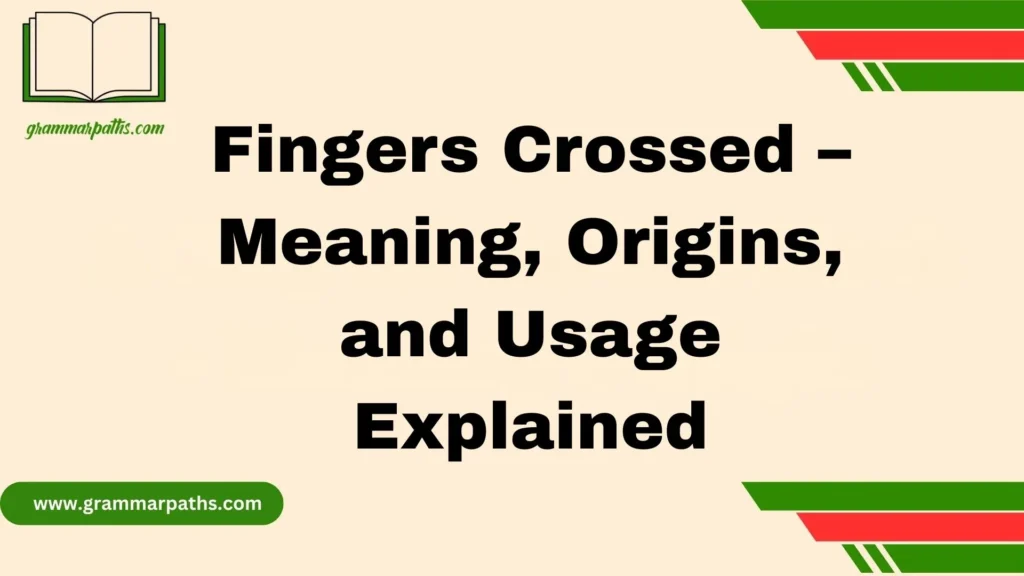When learning casual American English greetings, one phrase you’ll hear often is “How is it going?”. This common expression is widely used in everyday conversations, especially in informal settings. Many English learners wonder if it is grammatically correct, how it differs from other greetings like “How are you?”, and when it’s appropriate to use. In this guide, we’ll explore the meaning, usage, and cultural context of this phrase so you can sound more natural when speaking English.
Unlike formal greetings such as “Good morning” or “How do you do?”, the phrase “How’s it going?” reflects friendly, relaxed communication. It’s a way to ask about someone’s well-being, but it’s not usually meant to receive a detailed answer. Most native speakers respond with short, casual replies like “Good, thanks”, or “Not bad”, keeping the tone light.
Understanding the difference between formal and informal greetings is essential for effective communication. Using the right phrase at the right time helps you connect better with friends, coworkers, or even strangers in social situations. By the end of this article, you’ll know when to say “How is it going?”, how to reply naturally, and how it compares to other common English greetings.
The Origins and Meaning of “How Is It Going?”
“How is it going?” is a phrase that has evolved over time in American English. Unlike “How are you?” which is more formal, “How is it going?” is idiomatic and casual, used primarily in informal interactions.
Origin:
- Likely emerged in the early 20th century in North America.
- Rooted in everyday conversation where people wanted a quick way to ask about someone’s general well-being or current activities.
- Over time, it became less about literal interpretation and more of a social greeting.
Literal vs. idiomatic meaning:
- Literally: “How is everything progressing?”
- Idiomatically: “Hello, how are you?” or “How’s everything?”
Example in use:
- Teacher to student: “Hey, Jamie, how is it going?” (Not necessarily expecting a detailed answer)
- Colleague in the office: “How is it going with the new project?” (Could prompt a short update)
Common Misconceptions About “How’s It Going?”
Many learners of English misunderstand the phrase and think it’s more formal or serious than it really is.
Common misconceptions include:
- Believing it’s equivalent to “How are you?” in a formal sense.
- Thinking that you must give a detailed update on your day.
- Misinterpreting tone—some may take it as critical, when it’s usually casual.
Quick tip: Most Americans use it as a polite greeting, not as a check-in for personal issues. Respond with a short, friendly answer unless the context suggests otherwise.
How “How Is It Going?” Differs from “How Are You?”
Though they seem similar, there are distinct differences in tone and usage:
| Phrase | Formality | Typical Setting | Example Response |
| How are you? | Formal | Emails, professional meetings | “I’m good, thank you.” |
| How is it going? | Casual/Informal | Hallways, social chats, lunch | “Pretty good, how about you?” |
Key differences:
- Formality: “How are you?” is more neutral and works in professional contexts.
- Tone: “How is it going?” is relaxed, friendly, and often paired with a smile or informal body language.
- Purpose: “How are you?” might warrant a more thoughtful answer. “How is it going?” usually expects a brief, casual reply.
Context Matters: Mishearing and Misinterpretation
The meaning of “How is it going?” often depends on context, tone, and relationship. Misinterpretation can occur if someone:
- Misreads sarcasm or humor.
- Assumes urgency when none exists.
- Uses it in writing where tone is unclear.
Examples:
- A student asks, “How is it going with your homework?” A teacher may interpret it as a check-in, while the student sees it as a casual greeting.
- A professional email: “How is it going on the report?” can be formal enough if paired with polite wording.
Tip: Pay attention to body language, setting, and previous interactions to correctly interpret intent.
Appropriate Situations to Use “How Is It Going?”
Knowing where and when to use this phrase is crucial. Using it in the wrong context can seem awkward or unprofessional.
Casual settings:
- Between friends or classmates
- During lunch breaks or informal gatherings
- Chatting in hallways or online group chats
Professional settings:
- Among colleagues in informal meetings
- Quick check-ins with a friendly tone
- Avoid in formal emails unless paired with formal structure
Not recommended for:
- First-time business introductions
- Formal academic reports
- Situations requiring strict professionalism
Example Table:
| Setting | Appropriate Usage? | Notes |
| Classroom (student-teacher) | ✅ Yes | Casual check-in |
| Job interview | ❌ No | Too informal |
| Email to supervisor | ⚠ Sometimes | Add formal context if used |
| Coffee with a colleague | ✅ Yes | Perfectly casual |
Nuances in Conversation: Beyond the Words
“How is it going?” carries subtle conversational cues:
- Tone: Can express genuine curiosity or casual friendliness.
- Emphasis: “How is it going?” vs. “How is it going?”—slight differences in curiosity.
- Regional variations: Common in the USA, less frequent in other English-speaking countries.
- Relationship factor: Closer friends expect informal replies; acquaintances may prefer polite, brief responses.
Case study:
- In a study at a US university, students reported that peers often use “How is it going?” as a starter for casual conversation, whereas faculty mostly used it in a neutral, polite context.
How to Respond to “How Is It Going?”
Responding appropriately can make conversations smoother and more natural. Consider these strategies:
Polite, casual responses:
- “Good, thanks! How about you?”
- “Pretty well, and you?”
- “Not bad, what’s up with you?”
Professional yet friendly:
- “Everything’s on track, thanks for asking.”
- “Going well, and you?”
When to share more:
- If the person is close or context requires detail, e.g., projects or schoolwork:
- “It’s going well; I just finished the research assignment you suggested.”
- “I’m doing great—just preparing for my presentation next week.”
Tip: Always reciprocate politely. Americans often view it as common courtesy rather than a request for deep discussion.
Alternatives to “How Is It Going?”
Using different greetings keeps conversations fresh and context-appropriate. Common alternatives include:
- How’s everything? – informal, casual
- What’s up? / Wassup? – very casual, friendly
- How’s your day? – can be casual or semi-professional
- How are things? – versatile across casual and professional contexts
Table: Alternative Phrases
| Phrase | Tone | Typical Use |
| How’s everything? | Casual | Friends, colleagues |
| What’s up? | Very casual | Friends, peers |
| How’s your day? | Semi-professional | Classmates, colleagues |
| How are things? | Casual-professional | Teachers, coworkers |
Common Mistakes and How to Avoid Them
Even frequent users make mistakes. Avoid these pitfalls:
- Overusing it in formal contexts: May seem unprofessional.
- Giving irrelevant or overly detailed answers: Could confuse casual greetings.
- Ignoring tone or body language: Misinterpretation risk increases.
- Assuming it’s the same everywhere: Cultural variations exist; not all English speakers use it casually.
Quick fix tips:
- Match tone with context.
- Keep replies concise unless invited to elaborate.
- Observe native speakers in classrooms, offices, or social settings.
Quick Tips for Mastering Casual Greetings
Here are practical tips for students, teachers, and professionals:
- Do: Use with peers, friends, and close colleagues.
- Do: Pair with a smile or friendly tone.
- Do: Reciprocate politely.
- Don’t: Use in formal reports or first-time professional introductions.
- Don’t: Overanalyze—it’s casual, not a life update request.
Summary Table for Easy Reference
| Phrase | Context | Response Example |
| How is it going? | Casual/friendly | “Good, how about you?” |
| How are you? | Professional/formal | “I’m well, thank you.” |
| How’s everything? | Casual/friendly | “All good, thanks!” |
| What’s up? | Very casual | “Not much, you?” |
Conclusion
The phrase “How is it going?” is not only grammatically correct but also one of the most common informal greetings in American English. It’s widely used in casual settings, whether among friends, coworkers, or acquaintances. While it’s not meant for deep conversations, it serves as a simple way to start small talk and show friendliness.
By learning how to use “How’s it going?” alongside other greetings like “What’s up?” or “How are you?”, you can sound more natural and confident when communicating in English. Remember, choosing between formal and casual greetings depends on the situation and the relationship you share with the other person. Mastering this difference is a small but powerful step toward speaking English fluently and comfortably.
FAQs
1. Is “How is it going?” grammatically correct?
Yes, it’s correct and commonly used in everyday English, especially in casual conversations.
2. How should I respond to “How’s it going?”
Typical answers include “Good,” “Pretty good,” or “Not bad.” Short and simple replies are expected.
3. Is it the same as “How are you?”
Both are greetings, but “How are you?” is slightly more formal, while “How’s it going?” is casual and relaxed.
4. Can I use it in professional settings?
Yes, but only in a casual workplace or with colleagues you know well. In formal situations, stick to greetings like “Good morning” or “How are you?”
5. What are other alternatives to “How is it going?”
Some popular options include “What’s up?”, “How have you been?”, and “How’s everything?”.

Emma Brooke is a passionate language expert and contributor at GrammarPaths.com, where she helps learners navigate the complexities of English grammar, idioms, and effective writing. With a strong academic background and years of teaching experience, Emma excels at turning tricky grammar rules into simple, practical lessons that readers can easily grasp.












